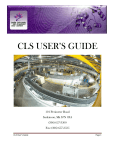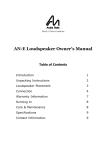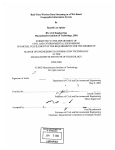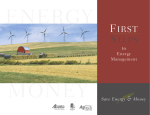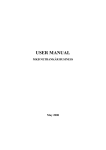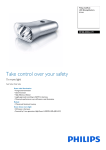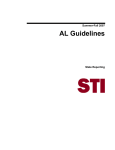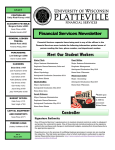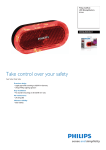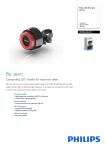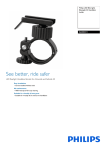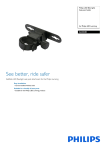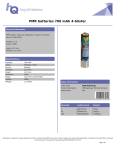Download User's Guide - The University of Winnipeg
Transcript
University of Winnipeg Green Campus User’s Guide by Lena Yusim Campus Sustainability Office University of Winnipeg 515 Portage Avenue R3B 2E9 sustainability.uwinnipeg.ca INTRODUCTION Dear Reader, T his Green User’s Manual is my summer 2011 project with the Campus Sustainability Office. I gathered the information from archived campus reporting, internet research, making phone calls, and many trips to the Millennium Library. We put in a lot of effort to ensure that the comparisons, facts, and analogies included were relevant and accurate to Winnipeg. Sometimes this meant asking some funny questions. At one point, when trying to calculate water savings after a bathroom retrofit, I had to call the Pan Am Pool and ask them how much water was in the pool (the main pool has 1 million imperial gallons!). Not a common question for the receptionist, I’m sure! I tried really hard to create simple and accurate analogies and calculations. I wanted the information to make sense, and to give a visual comparison to every reader. My hope for the Green User’s Manual is that it will allow you to better understand how your daily actions impact the environment, and how different changes can decrease your impact in different ways. We hope that our work will inspire you, the way it does for us, to consider making a few (or more than a few!) changes to your lifestyle — at school, and maybe at home too! • Lena Yusim We hope that our work will inspire you to consider making a few changes to your lifestyle — at school, and maybe at home too! Green Campus User’s Manual | Campus Sustainability Office | University of Winnipeg | 515 Portage Avenue R3B 2E9 | sustainability.uwinnipeg.ca | Page 2 Table of Contents (click on a topic to go to that page) How Can I Help Reduce the University’s Energy Use? 1. Unplug your appliances 2. Change your computer settings 3. Turn off light switches 4. Read up on UW’s initiatives What’s Your Ride? 1. Daily commute graph 2. Ride a bike 3. Walk to and from campus 4. Take the bus 5. Reduce business travel 6. eco-Drive How Can I Use Less Stuff on Campus? 1. Reduce 2. Reuse 3. Compost 4. Recycle What are the University’s Smoking and Fragrance Guidelines? 1. Respect scent-free guidelines 2. Follow smoke-free guidelines What Does Sustainable Eating Mean? 3. Eat local food 4. Eat organic food Am I Wasting Water? 1. Use less water 2. Waste less water 3. BYOB — Bring your own bottle Credits: Design: Suzanne Martin All images © 2011 www.clipart.com unless otherwise noted Image page 7 © 2011 www.istockphoto.com Image page 12 http://www.flickr.com/photos/sachom/2695269830/sizes/o/ licensed under Creative Commons Attribution Share Alike 2.0 (www.creativecommons.org/licenses/by-sa/2.0) Green Campus User’s Manual | Campus Sustainability Office | University of Winnipeg | 515 Portage Avenue R3B 2E9 | sustainability.uwinnipeg.ca | Page 3 Green Campus ... ENERGY How Can I Help Reduce the University’s Energy Use? Read Up on UW Initiatives Unplug your Appliances Change your Computer Settings Turn off Light Switches Green Campus User’s Manual | Campus Sustainability Office | University of Winnipeg | 515 Portage Avenue R3B 2E9 | sustainability.uwinnipeg.ca | Page 4 How Can I Save Energy ... Did You Know? Phantom power makes up enough energy on campus each year to power 130 Canadian homes for a year! UNPLUG YOUR APPLIANCES A lthough a device is turned off, it is using energy when it is plugged into a socket. This is called “phantom power” and it accounts for 10% of UW campus energy consumption by appliances. Use power strips • Power strips are multi socket plugins that can be turned off with a switch to cut off phantom power while the strip stays plugged into the wall. Unplug appliances • You can prevent phantom power by unplugging appliances. Green Campus User’s Manual | Campus Sustainability Office | University of Winnipeg | 515 Portage Avenue R3B 2E9 | sustainability.uwinnipeg.ca | Page 5 How Can I Save Energy ... CHANGE YOUR COMPUTER SETTINGS C omputer’s sleep mode uses ¼ the amount of energy as awake mode. Use sleep or standby mode • Turns off the hard drive and display but memory remains active. • Printers have an energy saver button right on the screen. Press it after you’ve finished your print job. Use max battery power setting • Control panel > power options > power scheme > max battery Change to dim brightness level • Use the function keys on the keyboard or adjust the brightness level with the buttons on your monitor. • Remember to turn off your monitor when leaving the room, even for a short amount of time. Did you Know? Don’t leave CD’s or DVD’s in the drives when not in use. Spinning drives suck battery power. Green Campus User’s Manual | Campus Sustainability Office | University of Winnipeg | 515 Portage Avenue R3B 2E9 | sustainability.uwinnipeg.ca | Page 6 How Can I Save Energy ... TURN OFF LIGHT SWITCHES T urn off light switches and upgrade to CFL light bulbs; a little bit of energy savings here and there adds up. Install motion detector lighting and use CFL light bulbs • On campus installation of motion detector lighting and switching to compact fluorescent light bulbs achieves 75% savings per installation. Turn off the lights • You can contribute by turning off the lights when you are the last person to leave any room. • Lecturers are encouraged to turn off the projector when it’s not being referred to. Green Tip! Natural light reduces eyestrain, increases productivity, and enhances comfort and well being! Green Campus User’s Manual | Campus Sustainability Office | University of Winnipeg | 515 Portage Avenue R3B 2E9 | sustainability.uwinnipeg.ca | Page 7 How Can I Save Energy ... Take Action! Join the Campus Sustainability Council or a Working Group; become an Eco-Rep for your office or department, or contact CSO for more info. READ UP ON UW’S INITIATIVES U Winnipeg is constantly working to • Rolling computer replacement reduce its energy impact. The program to update IT infrastructure University also tracks and reports on with more energy efficient monitors its energy consumption and GHG and computers. impact annually. • 95% of campus roofs have been replaced. Read up on recent UW initiatives • All new buildings are at minimum • Installation of two electric boilers LEED Silver. and updated boiler controls systems to reduce GHG impact of energy use and reduce heating costs. Green Campus User’s Manual | Campus Sustainability Office | University of Winnipeg | 515 Portage Avenue R3B 2E9 | sustainability.uwinnipeg.ca | Page 8 Green Campus ... TRANSPORTATION What's Your Ride? Take the Bus Ride a Bike Reduce Business Travel Walk to and from Campus eco-Drive Green Campus User’s Manual | Campus Sustainability Office | University of Winnipeg | 515 Portage Avenue R3B 2E9 | sustainability.uwinnipeg.ca | Page 9 Annual GHG Impact of Your ... DAILY COMMUTE 1600 Kg of CO2e 1400 1200 1000 800 600 Alone Carpool with 1 400 200 Carpool with 2 0 SUV Small Car Hybrid Bus Bike/Walk Green Campus User’s Manual | Campus Sustainability Office | University of Winnipeg | 515 Portage Avenue R3B 2E9 | sustainability.uwinnipeg.ca | Page 10 What`s Your Ride ... Did You Know? On average, bicycles cover 3 kilometers in only 15 minutes! F or trips under 5km, cycling is the fastest mode of transportation. Utilize the new bike lab and join Ice Riders • You can access the UWSA Bike lab to maintain your bicycle on campus and to develop your bike maintenance skills. The UWSA Ice Riders team supports safe cycling all year — even in the winter months. RIDE A BIKE • Bike racks are located near entrances to campus, or fill out the underground bike parking application. Keep your bike locked up safely • Use a U-lock. Know the bike routes downtown and in your neighborhood • Check out the Downtown Winnipeg Map. Green Campus User’s Manual | Campus Sustainability Office | University of Winnipeg | 515 Portage Avenue R3B 2E9 | sustainability.uwinnipeg.ca | Page 11 What`s Your Ride ... WALK TO AND FROM CAMPUS W alk to campus if you can manage the distance from your home. You’ll save money on gas, burn some calories, and feel great! Utilize the SafeWalk & SafeRide program • On campus escorts assist staff and students to get to their bus stop, car or home safely. Green Tip! Walking contributes to healthy communities by reducing traffic congestion, noise, and air pollution. Green Campus User’s Manual | Campus Sustainability Office | University of Winnipeg | 515 Portage Avenue R3B 2E9 | sustainability.uwinnipeg.ca | Page 12 What`s Your Ride ... Did You Know? In 4 years, a car driver uses more energy and creates more air pollution than a transit passenger in 40 years. D uring rush hour there are on average 1.2 persons per car. This means 2 buses can carry as many people as 100 cars during rush hour. Take Active Transit • In Canada, city drivers account for over 40% energy for transportation while transit systems account for only 2%. • There are 58 different bus routes TAKE THE BUS servicing UW campus, with 101 bus stops servicing these routes in close proximity to campus. Find your bus route • Check transit fares to compare prices. A Post Secondary Bus pass costs $60.10 as opposed to $75.35 for a regular bus pass. These can be purchased at UWSA Info Booth and Petrified Sole Used Bookstore. Green Tip! The Downtown Spirit shuttle goes through all of downtown and is free! Click here for routes and schedules. Green Campus User’s Manual | Campus Sustainability Office | University of Winnipeg | 515 Portage Avenue R3B 2E9 | sustainability.uwinnipeg.ca | Page 13 What`s Your Ride ... Green Tip! Mix business and leisure — avoid an additional trip by combining business travel with a holiday. REDUCE BUSINESS TRAVEL T he average Canadian releases enough fossil fuels to drive around the equator of the Earth 16 times every year. Minimize travel, especially by air, to avoid GHG from air travel • Telecommute with computer programs like Cisco Online Conferencing. • Compare the different modes of travel by using a travel calculator, like this British version. Purchase carbon offsets • While it is always better to avoid travel — especially air travel — carbon offsets can help mitigate the impact of trips you do take. Learn more about it here. Green Campus User’s Manual | Campus Sustainability Office | University of Winnipeg | 515 Portage Avenue R3B 2E9 | sustainability.uwinnipeg.ca | Page 14 What`s Your Ride ... haring a ride 2 times a week can reduce enough fossil fuel to drive around the equator of the Earth twice in one month. S Drive a hybrid vehicle • If you have to drive, consider a hybrid vehicle as your next car purchase. Carpool • Share rides to work and school with neighbours, coworkers or classmates. Think before you drive • Don’t just carpool to work. Share rides to special events, children’s activities, and errands. eco-DRIVE Did You Know? 80% of people still drive to work alone. Green Campus User’s Manual | Campus Sustainability Office | University of Winnipeg | 515 Portage Avenue R3B 2E9 | sustainability.uwinnipeg.ca | Page 15 Green Campus ... USING LESS How Can I Use Reduce Less Stuff on Campus? Reuse Compost Recycle Green Campus User’s Manual | Campus Sustainability Office | University of Winnipeg | 515 Portage Avenue R3B 2E9 | sustainability.uwinnipeg.ca | Page 16 Using Less ... C onsumer goods require 400 times their weight in material resources to be produced and disposed of. Photocopy and print on both sides of the paper • This is easy to do, since campus copy machines print double-sided by default. Avoid one-time-use containers by using reusable take out containers • If you do use single-use containers, remember that Diversity Foods, Soma and Stella’s single-use food packaging is compostable. Use digital textbooks • The U of W Bookstore offers digital textbooks, which avoids paper altogether. REDUCE Green Tip! Avoid printing entire web pages, Power Point presentations, and emails. Use textonly or printerfriendly modes, and print only what you need. Green Campus User’s Manual | Campus Sustainability Office | University of Winnipeg | 515 Portage Avenue R3B 2E9 | sustainability.uwinnipeg.ca | Page 17 Using Less ... Green Tip! Trade stuff with friends and family instead of consuming new products — especially if you only need it for one class. Use WebCT for submitting assignments, course outlines, tests, and other notes electronically • Faculty and staff can learn more about how to use WebCT and other electronic course delivery methods through the Centre for Teaching, Learning, and Technology. REDUCE Rethink that new and “improved” gadget • Use items like cell phones, iPods, and computers until they’re dead. Green Campus User’s Manual | Campus Sustainability Office | University of Winnipeg | 515 Portage Avenue R3B 2E9 | sustainability.uwinnipeg.ca | Page 18 Using Less ... Did You Know? Reusable takeout containers are sold in the cafeteria for $3.00 - $5.00. REUSE S ave the expense of using disposRent textbooks able take out containers from • The U of W Bookstore offers textDiversity Food, they cost an extra $0.50 book rental. The book costs half with every meal. Use travel mugs and price, and allows for reuse of the reusable food containers book over and over again. Reuse office supplies • Reuse items like envelopes, file folders and paper clips for mail and reports. Reuse school supplies • Borrow from a friend or buy used lab coats, dissection kits, and other supplies, especially if you only need them for one course. Green Campus User’s Manual | Campus Sustainability Office | University of Winnipeg | 515 Portage Avenue R3B 2E9 | sustainability.uwinnipeg.ca | Page 19 Using Less ... D id you know that 40% of things you dispose of are compostable? On campus you can compost: • ALL food scraps. This includes cooked or raw food, tea bags and coffee grounds. • ALL take-out packaging from Diversity Foods, Soma Café, and Stella’s Café. This includes containers, cutlery, napkins, straws, etc. • Place All your compostable material in a COMPOST BIN. Bins are located throughout food service areas and in some common spaces. Contact the Campus Sustainability Office if you would like a small compost bucket for your department. COMPOST Green Tip! Besides being great for the soil, composting also helps reduce pollution from garbage transportation. Green Campus User’s Manual | Campus Sustainability Office | University of Winnipeg | 515 Portage Avenue R3B 2E9 | sustainability.uwinnipeg.ca | Page 20 Using Less ... Did You Know? You can save a tree by recycling a 1m tall stack of newspaper. RECYCLE ecycling aluminum uses 95% less energy than producing the metal from raw materials, recycling steel saves 60%, newspaper 40% and plastics 70% of the energy. R Recycle old gadgets • If you are ready to upgrade, recycle old cell phones or other gadgets by donating them or giving them to a friend. Use recycled content • Use paper, school supplies, and office supplies made of recycled content, and use them until they are totally done. Properly recycle dead batteries • Includes laptop, cell phone, etc. • Bins can be found in office mail rooms and the Info Booth and UWSA offices. Green Campus User’s Manual | Campus Sustainability Office | University of Winnipeg | 515 Portage Avenue R3B 2E9 | sustainability.uwinnipeg.ca | Page 21 Green Campus ... SMOKE AND SCENT What are the University’s Smoking and Fragrance Guidelines? Scent-Free and Smoke-Free Guidelines Green Campus User’s Manual | Campus Sustainability Office | University of Winnipeg | 515 Portage Avenue R3B 2E9 | sustainability.uwinnipeg.ca | Page 22 Scent and Smoke-Free ... T FOLLOW GUIDELINES here are people on campus who Follow smoke-free guidelines have allergies to smoke and strong • UWinnipeg has been designated a scents. We’re trying to make UW a smoke free campus. If you smoke, healthy place for all campus members. please be respectful and smoke away from doorways and off Respect the UW scent-free guideline campus property. • Hair products and body lotions, etc. should be scent free. • Help us create an inclusive campus for all by not wearing perfumes / colognes. Green Tip! These guidelines will improve the air around us and protect campus users who suffer from asthma and allergies. Green Campus User’s Manual | Campus Sustainability Office | University of Winnipeg | 515 Portage Avenue R3B 2E9 | sustainability.uwinnipeg.ca | Page 23 Green Campus ... SUSTAINABLE FOOD What Does Sustainable Eating Mean? Eat Local Food Eat Organic Foods Green Campus User’s Manual | Campus Sustainability Office | University of Winnipeg | 515 Portage Avenue R3B 2E9 | sustainability.uwinnipeg.ca | Page 24 Sustainable Food ... Did you Know? To move a head of lettuce from the West Coast to the East coast takes 36 times more energy than the head of lettuce contains. T he production of 1 calorie from beef needs 40 calories of fuel; 1 calorie from milk needs 14 fuel calories, and 1 calorie from grains needs 2.2 calories of fossil fuels. Eat less meat • Try a vegetarian diet. Eat less meat, and eat locally grazed meat when you do. Try to avoid beef, as it is the top GHG contributor. EAT LOCAL FOOD Eat locally grown food and locally raised meat • Transportation of food accounts for 30% of the vehicles on the road right now. • You can help by eating and growing local food. • Diversity Foods and Soma Café source local foods, meaning less GHG from transportation of foods and shorter food mileage. Green Campus User’s Manual | Campus Sustainability Office | University of Winnipeg | 515 Portage Avenue R3B 2E9 | sustainability.uwinnipeg.ca | Page 25 Sustainable Food ... I n Manitoba, the fertilizers used in conventional agriculture were responsible for 21% of province-wide GHG emissions in 2008. Support better land use • To support better land use, buy fair trade and certified organic coffee, vegetables and fruit, meat, and anything else you can that is certified organic. EAT ORGANIC FOOD Eat organic food • Supporting organic agriculture is an important way of reducing your personal climate change impact. It is also healthier and tastier. Did you Know? On average, 10 grams of vegetable protein are needed to generate 1 gram of animal protein. Green Campus User’s Manual | Campus Sustainability Office | University of Winnipeg | 515 Portage Avenue R3B 2E9 | sustainability.uwinnipeg.ca | Page 26 Green Campus ... WATER Am I Wasting Water? Use Less Water Waste Less Water Bring Your Own Bottle Green Campus User’s Manual | Campus Sustainability Office | University of Winnipeg | 515 Portage Avenue R3B 2E9 | sustainability.uwinnipeg.ca | Page 27 Saving Water ... Did you Know? Industrial livestock production is a major cause of air and water pollution, global warming, land degradation, and the loss of biodiversity. USE LESS WATER L ivestock currently use 8% of the • Campus eateries sourcing local and planet’s fresh water, mostly for the ethically raised meat let you enjoy irrigation of crops to feed the livestock. your favourite foods without as much of the harm. Eat less meat to save water • Of all livestock, beef uses the most water to produce and distribute at 6810 liters per pound of beef. That’s enough water to fill 100 standard sized bath tubs. Green Campus User’s Manual | Campus Sustainability Office | University of Winnipeg | 515 Portage Avenue R3B 2E9 | sustainability.uwinnipeg.ca | Page 28 Saving Water ... M otion sensor taps in the bathrooms on campus help save water by only dispensing water when hands are directly under it. WASTE LESS WATER • Compared to conventional washroom, UW washrooms with motion sensors save enough water annually to fill the main pool at Pan Am Pool. • Updates on toilets and taps in older Save water with low flow and mobuildings also make campus washtion sensor washrooms rooms more accessible for those • Low flow motion sensor toilets flush with special needs. when you get up. The flush uses less water and motion sensors help prevent water from running. Green Tip! A tap that leaks 1 drop per second wastes 25 liters a day. A running toilet wastes 900 liters a day! Did You Know? A running tap uses about two gallons of water per minute — that’s the same as pouring four 2L bottles of pop down the drain. Green Campus User’s Manual | Campus Sustainability Office | University of Winnipeg | 515 Portage Avenue R3B 2E9 | sustainability.uwinnipeg.ca | Page 29 Saving Water ... Did You Know? Despite being in demand by recyclers, more than 80% of plastic bottles are thrown away. I n 2009, UW banned the sale of bottled water on campus to highlight our support of public access to high quality drinking water and raise awareness of the environmental impact of bottled beverages. BYOB BYOB — Bring Your Own Bottle! • Check out the water bottle re-fill stations on campus. Refill your water bottle all day long. • Visit the water station with reusable cups on site in Riddell Hall. ALSO! Did You Know? Producing a new plastic bottle takes 6.74 times more water than the bottle can hold. Green Campus User’s Manual | Campus Sustainability Office | University of Winnipeg | 515 Portage Avenue R3B 2E9 | sustainability.uwinnipeg.ca | Page 30 Learn More ... USEFUL READING Hull, C. (2011) Climate Change Connection. http://www.climatechangeconnection.org/emissions/ManitobaGHGEmissions-Energy.htm Leslie, B., McAleer, M. J., & Small, S. (2008) GHG Emissions per capita. http://www.conferenceboard.ca/hcp/details/environment/greenhouse-gasemissions.aspx Suzuki, D., & Boyd, D., R. (2008) David Suzuki’s Green Guide. Green Tip! Plant a tree, grow some vegetables, join a group, pick up litter — small changes add up! Shimo-Barry, A., & Maron, C., J. (2008) The Environment Equation. Green Campus User’s Manual | Campus Sustainability Office | University of Winnipeg | 515 Portage Avenue R3B 2E9 | sustainability.uwinnipeg.ca | Page 31 Learn More ... For more information please do not hesitate to contact the UW Campus Sustainability Office Visit our website: sustainability.uwinnipeg.ca Call our office: 204.789.1479; 204.789.1478 This project was made possible through the generosity of the Winnipeg Foundation. CONTACT US Pass it On! Encourage friends and coworkers to make more conscious choices in their daily lives. Together, we can make a difference! Green Campus User’s Manual | Campus Sustainability Office | University of Winnipeg | 515 Portage Avenue R3B 2E9 | sustainability.uwinnipeg.ca | Page 32
































